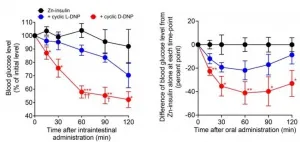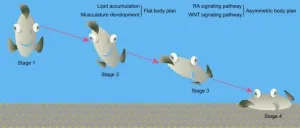Toward painless oral insulin administration
Can insulin be administered orally by simply mixing it with a small intestine permeable cyclic peptide?
2021-04-26
(Press-News.org) Researchers from Kumamoto University, Japan have found that DNP peptide, a small intestine-permeable cyclic peptide originally used as an insulin additive to improve absorption into the small intestinal, lowers blood glucose levels in mice. They also found that insulin can be administered orally by simply adding D-form DNP peptide (D-DNP) peptide to injectable insulin used in clinical practice. This study is expected to provide a basis for the development of oral insulin using DNP peptides.
Insulin therapy by self-injected insulin is currently the best way to control blood glucose. However, self-injection is painful and a major burden for many diabetics. The development of oral insulin is strongly desired to improve their quality of life. Although it has been over 100 years since the discovery of insulin, oral insulin has yet to be developed. This is mainly because insulin is not absorbed in the small intestine and it is broken down in the gastrointestinal tract. To solve this problem, researchers used a DNP peptide that can permeate large molecules across the small intestine, which they previously discovered, and an insulin hexamer that was created by adding zinc.
First, the research team synthesized a DNP peptide using D-amino acids (D-DNP peptide) to inhibit the gastrointestinal degradation of DNP. Then, to reduce the gastrointestinal degradation of insulin, researchers created an insulin hexamer (zinc insulin hexamer) by combining zinc chloride and insulin. A mixture of the D-DNP peptide and insulin hexamer was then administered into the intestinal tracts of mice to study the absorption rate. Five minutes after administration, insulin was detected in the portal blood, and blood glucose levels started decreasing between 15 to 60 minutes after administration. The reduced glucose levels were sustained until at least 120 minutes after administration. Additionally, when the mixture was administered orally, blood glucose level began decreasing after 15 minutes and was maintained for least 120 minutes. For both administration methods, the D-DNP peptide produced a stronger hypoglycemic effect than a L-DNP peptide synthesized from L-amino acids. Furthermore, when the mixture was administered intraintestinally and orally to diabetic model mice, blood glucose levels began decreasing after 30 minutes.
Based on their previous work, and the fact that many insulin injections already contain zinc insulin hexamers, the researchers hypothesized that oral insulin could be developed by adding the D-DNP peptide to insulin injections currently in use. Thus, they added the peptide to HumulinR3/7 (an injectable insulin) and tested it on mice orally.
Their positive results suggest that oral insulin development is possible by simply adding D-DNP peptide to existing insulin injection formulations because the combination of D-DNP peptide with a zinc insulin hexamer improves insulin absorption in the small intestine.
"Our study shows that we were able to build a foundation for the development of oral insulin using D-DNP peptides," said Associate Professor Shingo Ito, leader of this study. "In the future, we expect to contribute to oral insulin drug discovery by developing a method to further enhance insulin absorption by the small intestine by optimizing the administration method."
INFORMATION:
This research was posted online in Molecular Pharmaceutics on 22 February 2021.
Source: Ito, S., Torii, Y., Chikamatsu, S., Harada, T., Yamaguchi, S., Ogata, S., ... Ohtsuki, S. (2021). Oral Coadministration of Zn-Insulin with d-Form Small Intestine-Permeable Cyclic Peptide Enhances Its Blood Glucose-Lowering Effect in Mice. Molecular Pharmaceutics. doi:10.1021/acs.molpharmaceut.0c01010
[Attachments] See images for this press release:

ELSE PRESS RELEASES FROM THIS DATE:
2021-04-26
Narcolepsy with cataplexy, or narcolepsy type 1 (NT1), is a rare and chronic neurological disease whose prevalence increased in children and adolescents after the administration of Pandemrix swine flu vaccine in 2009-2010. It is an autoimmune disease to which a specific inherited tissue type (HLA-DQB1*0602) predisposes people.
The disease mechanism of NT1 was investigated in a collaborative study carried out by PhD student Arja Vuorela and university researcher Dr. Tobias Freitag, working in the research groups of Prof. Outi Vaarala and Prof. Seppo Meri. The study analyzed the cell-mediated immune response targeting ...
2021-04-26
The colonization of the seafloor is one of the most important events in evolutionary history, leading to an explosive radiation and large-scale morphological diversification of marine phyla. Flatfishes are one of the most successful groups of seafloor colonizers and have evolved the most specialized body plan (i.e., flat and asymmetrical) among the teleosts. However, the origin and formation mechanism of the peculiar morphology of flatfishes had long been unclear.
Now, researchers from the Kunming Institute of Zoology of the Chinese Academy of Sciences ...
2021-04-26
Announcing a new article publication for BIO Integration journal. In this mini review article the authors Meiyu Qiu and Pei Li from Korea Advanced Institute of Science and Technology (KAIST), Daejeon, Republic of Korea summarize CRISPR/Cas-based Diagnostics and Gene Therapy.
Clustered regularly interspaced short palindromic repeats (CRISPR) technology, an easy, rapid, cost-effective, and precise gene-editing technique, has revolutionized diagnostics and gene therapy. Fast and accurate diagnosis of diseases is essential for point-of-care-testing (POCT) and specialized medical institutes. The CRISPR-associated (Cas) proteins system shed light on the new diagnostics methods at point-of-care (POC) owning to its advantages. In addition, CRISPR/Cas-based gene-editing ...
2021-04-26
People's ability to perceive speech sounds has been deeply studied, specially during someone's first year of life, but what happens during the first hours after birth? Are babies born with innate abilities to perceive speech sounds, or do neural encoding processes need to age for some time?
Researchers from the Institute of Neurosciences of the University of Barcelona (UBNeuro) and the Sant Joan de Déu Research Institute (IRSJD) have created a new methodology to try to answer this basic question on human development.
The results, published in the Nature's open-access journal Scientific Reports, ...
2021-04-26
Not all stars shine brightly all the time. Some have a brightness that changes rhythmically due to cyclical phenomena like passing planets or the tug of other stars. Others show a slow change in this periodicity over time that can be difficult to discern or capture mathematically. KAUST's Soumya Das and Marc Genton have now developed a method to bring this evolving periodicity within the framework of mathematically "cyclostationary" processes.
"It can be difficult to explain the variations of the brightness of variable stars unless they follow a regular pattern over time," says Das. "In this study we created methods that can explain the evolution of the brightness of a variable star, even if it ...
2021-04-26
Per- and polyfluoroalkyl substances (PFAS) in ski wax have been receiving a lot of attention recently, but waxes constitute only a limited part of the problem of the PFAS group of toxicants.
PFAS are a large group of man-made fluorocarbon toxicants, and you are most likely full of them. The toxic substances don't break down and instead accumulate, both in nature and in your body.
"Due to their extensive use, humans and animals all over the world are continuously exposed to PFAS," says Håkon Austad Langberg, a PhD candidate at the Norwegian University of Science and Technology (NTNU) who has studied several of them in the last few years.
PFAS are used in many different products beyond the fluorinated ski wax that ends up in the ground on ski slopes and on trails, ...
2021-04-26
The corona pandemic has made us all focus on new ways of organizing our work. More and more companies and organizations around the world are considering how to meet their employees' demand for flexibility while at the same time reducing their office space and expensive rents.
There are advantages and disadvantages to working from home, and many factors that affect the peoples' experience of it, such as their job function, age and seniority, whether they have children, whether they are a manager or employee, etc.
Researchers from DTU Management have identified six main areas that company managers should focus on when developing strategies for remote work in future.
Associate Professor at DTU Management Christine ...
2021-04-26
People who take a commonly-prescribed drug for inflammatory bowel disease (IBD) should not assume they are protected after a first dose of COVID-19 vaccine, after a large-scale study found many had poor antibody responses.
The research measured antibody responses after vaccination with the Pfizer/BioNTech or the Oxford/AstraZeneca COVID-19 vaccine in 865 people treated with infliximab, an anti-tumour necrosis factor (anti-TNF) biologic drug, prescribed to around two million people worldwide. Anti-TNF drugs are effective treatments for immune-mediated inflammatory ...
2021-04-26
The Chauvet Cave, which lies by the entrance to the Gorges of the Ardèche, is home to the world's oldest cave paintings, dating back 36,000 years. Their state of preservation and aesthetic qualities earned them a spot on the World Heritage List in 2014, 20 years after their discovery. The location of the cavern--surrounded by a remarkable landscape, next to the Pont d'Arc natural archway--raises the question of whether the people who executed these artworks looked and walked out upon the same landscape as today. Did they see the same natural archway? Scientists from the CNRS, Université Savoie Mont Blanc, and the Muséum National d'Histoire Naturelle1 ...
2021-04-26
Researchers from Skoltech (Russia) and their colleagues from SINTEF (Norway) have developed a mathematical model of freezing water droplets moving in cold air. This model is a part of a joint RFBR-supported Russian-Norway research project. The project is focused on predicting ice accretion on ships and other offshore structures operated in Arctic climate, which may interfere with their proper functioning and endanger crew members and cargo. The paper was published in the journal Energies.
Ships travel in cold northern waters under constant bombardment by tiny water droplets populating the chilly air. ...
LAST 30 PRESS RELEASES:
[Press-News.org] Toward painless oral insulin administration
Can insulin be administered orally by simply mixing it with a small intestine permeable cyclic peptide?




